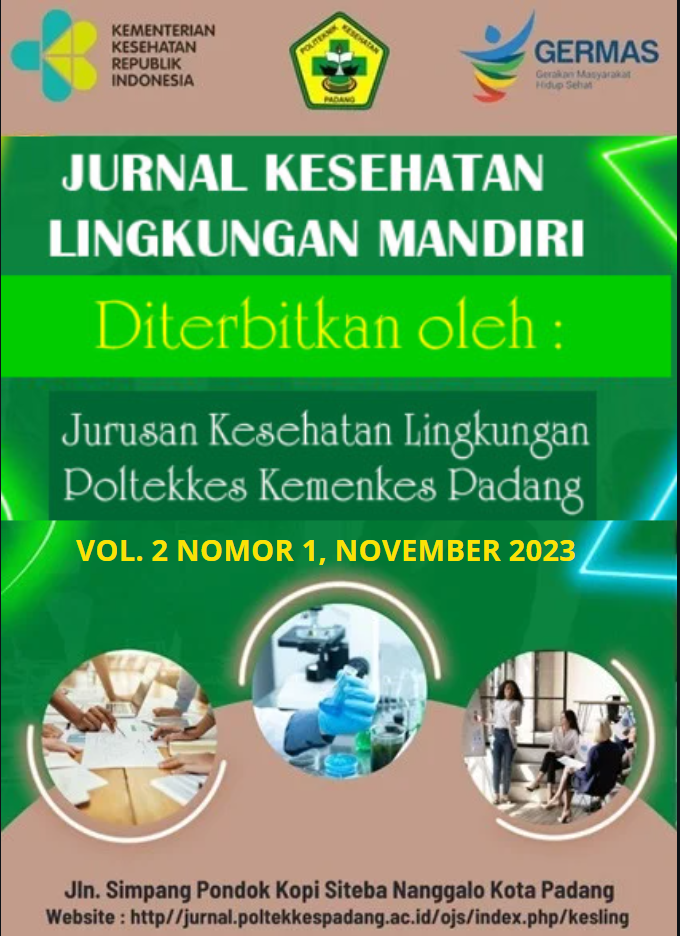Analisis Spasial Faktor Risiko Lingkungan pada Balita Stunting di Kecamatan Payung Sekaki Kabupaten Solok Tahun 2023
Abstract
Environmental risks have an influence on the incidence of stunting in toddlers caused by chronic malnutrition and repeated infections, especially in the First 1000 Days of Life (1000 HPK). One of the highest stunting contributing areas in Solok Regency is Payung Sekaki District in the Sirukam Health Center working area, there are 112 cases of stunting toddlers spread across 3 villages, namely Nagari Sirukam, Nagari Supayang and Nagari Aie Luo. The purpose of this study was to determine the spatial distribution of environmental risk factors in stunting toddlers in Payung Sekaki District, Solok Regency in 2023. The method used in this research is quantitative descriptive analysis method. The number of samples was 73 houses. Data analysis was carried out univariately and spatially using Microsoft Excel software and overlay on QGIS. This research produces information in the form of spatial distribution maps with low, medium and high classifications. With this research, it is known that Jorong Gantiang is the jorong with the highest incidence of stunting with 14 cases, Jorong Lubuak Pulai with 12 cases, and 3 jorong with moderate cases and 6 other jorong with low stunting cases. The high incidence of stunting in Payung Sekaki Sub-district is influenced by several environmental risk factors, namely the physical condition of the house, the provision of clean water, the management of waste water and feces, and having a history of recurrent infectious diseases such as diarrhea and ARI.
Downloads
References
Permenkes. Peraturan Menteri Kesehatan Republik Indonesia Nomor 2 Tahun 2020 Tentang Standar Antropometri Anak. at (2020).
Kesehatan, K. Hasil studi status gizi indonesia (SSGI) tingkat nasional, provinsi, dan kabupaten/kota tahun 2021. (2021).
Kesehatan, K. Buku Saku Hasil Survei Status Gizi Indonesia (SSGI) 2022. (2022).
Sosial, K. Kebijakan pencegahan dan penanganan stunting bagi SDM KESOS (2 JP). Modul vol. 1 at (2021).
Apriluana, G. Analisis Faktor-Faktor Risiko terhadap Kejadian Stunting pada Balita ( 0-59 Bulan ) di Negara Berkembang dan Asia Tenggara. Media Litbangkes 28, 247–256 (2018).
Kab.Solok, D. Prevalensi Balita Stunting Agustus 2022. (2022).
Icha Istiqammah. AAnalisis Spasial Terhadap Kejadian Stunting Pada Balita 24-59 Bulan Di Kecamatan Bolo Kabupaten Bima Tahun 2021. (UIN ALAUDDIN MAKASSAR, 2022).
Utari, L. F. Hubungan Kondisi Fisik Rumah Dengan Kejadian Stunting pada Balita 24-59 Bulan di Desa Secanggang Kabupaten Langkat. at http://repository.uinsu.ac.id/18532/1/cover dan lainnya.pdf (2022).
Oktafriawan, P. D., Subagiyo, A. & Aini, N. Hubungan Sanitasi Lingkungan Fisik Rumah Dengan Kejadian Balita Stunting di Wilayah Kerja Puskesmas Banyumas Tahun 2023. at http://123.231.148.147:8908/index.php?p=show_detail&id=34107&keywords= (2023).
Kesehatan, K. Peraturan Menteri Kesehatan RI No.3 Tahun 2014 tentang Sanitasi Total Berbasis Masyarakat. 13–15 at (2014).
Suwatanti, E. & Widiyaningrum, P. Sejarah Artikel: Diterima 11 Januari. J. MIPA 40, 1–6 (2017).
Djara, V. A. D., Andriyana, Y. & Noviyanti, L. Modelling the Prevalence of Stunting Toddlers Using Spatial Autoregressive With Instrument Variable and S-Estimator. Commun. Math. Biol. Neurosci. 2022, 1–23 (2022).
Gupta, A. K. & Santhya, K. G. Proximal and contextual correlates of childhood stunting in India: A geo-spatial analysis. PLoS One 15, (2020).
Indarto & Faisal, A. Konsep Dasar Analisis Spasial. (ANDI, 2012).
Wulandari, Rahayu, Fitri, D. Hubungan Sanitasi Lingkungan Dan Riwayat Penyakit Infeksi Dengan Kejadian Stunting Di Wilayah Kerja Puskesmas Kerkap Kabupaten Bengkulu Utara Tahun 2019. Avicenna J. Ilm. 14, 6–13 (2019).
Copyright Notice
Pernyataan Hak Cipta dan Lisensi
Dengan mengirimkan manuskrip ke Jurnal Kesehatan Lingkungan Mandiri, penulis setuju dengan kebijakan ini. Tidak diperlukan persetujuan dokumen khusus.
Hak Cipta :
Lisensi Creative Commons Atribusi-NonKomersial-BerbagiSerupa 4.0 Internasional
Hak cipta atas artikel apa pun di Jurnal Kesehatan Lingkungan Mandiri dipegang penuh oleh penulisnya di bawah lisensi Creative Commons CC BY-NC-SA 4.0.
- Hak cipta pada setiap artikel adalah milik penulis.
- Penulis mempertahankan semua hak mereka atas karya yang diterbitkan, tak terbatas pada hak-hak yang diatur dalam laman ini.
- Penulis mengakui bahwa Jurnal Kesehatan Lingkungan Mandiri sebagai yang pertama kali mempublikasikan dengan lisensi Creative Commons Atribusi 4.0 Internasional (CC BY-NC-SA-4.0).
- Penulis dapat memasukan tulisan secara terpisah, mengatur distribusi non-ekskulif dari naskah yang telah terbit di jurnal ini kedalam versi yang lain (misal: dikirim ke respository institusi penulis, publikasi kedalam buku, dll), dengan mengakui bahwa naskah telah terbit pertama kali pada Jurnal Kesehatan Lingkungan Mandiri.
- Penulis menjamin bahwa artikel asli, ditulis oleh penulis yang disebutkan, belum pernah dipublikasikan sebelumnya, tidak mengandung pernyataan yang melanggar hukum, tidak melanggar hak orang lain, tunduk pada hak cipta yang secara eksklusif dipegang oleh penulis.
- Jika artikel dipersiapkan bersama oleh lebih dari satu penulis, setiap penulis yang mengirimkan naskah menjamin bahwa dia telah diberi wewenang oleh semua penulis bersama untuk menyetujui hak cipta dan pemberitahuan lisensi (perjanjian) atas nama mereka, dan setuju untuk memberi tahu rekan penulis persyaratan kebijakan ini. Jurnal Kesehatan Lingkungan Mandiri tidak akan dimintai pertanggungjawaban atas apa pun yang mungkin timbul karena perselisihan internal penulis.
Lisensi :
Jurnal Kesehatan Lingkungan Mandiri diterbitkan berdasarkan ketentuan Lisensi Creative Commons Atribusi-NonKomersial-BerbagiSerupa 4.0 Internasional (CC BY-NC-SA 4.0). Lisensi ini mengizinkan setiap orang untuk :
Menyalin dan menyebarluaskan kembali materi ini dalam bentuk atau format apapun serta menggubah, memperbaiki, dan membuat ciptaan turunan, bahkan untuk kepentingan komersial, selama mereka mencantumkan kredit kepada Penulis atas ciptaan asli.

















